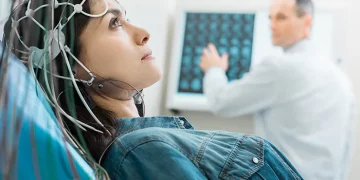The Unexpected Link Between Light and Mental Clarity
For years, we’ve blamed screens for mental fatigue, eye strain, and even emotional dysregulation. But what if screens—and specifically how we interact with light—could be redesigned to improve the way we think and feel? Emerging technologies are challenging the long-standing assumption that screen time only harms. Instead, they propose that with the right filters and spectral control, screens and wearables can actually enhance cognitive performance and emotional stability.
Understanding Blue Light: Enemy or Ally?
Blue light has become a public health villain, blamed for everything from disrupted circadian rhythms to elevated anxiety. But this wavelength is not inherently harmful. Blue light plays an essential role in regulating alertness, reaction time, and mood through its influence on melanopsin receptors and the suprachiasmatic nucleus in the brain. The problem lies in its timing, intensity, and exposure context. Wearables that filter, modulate, or strategically deliver blue light aim to restore its cognitive benefits without the downsides.
The Rise of Blue-Light Wearables
Today’s market offers more than just amber-lens glasses. We now see a surge in AI-enhanced light-filtering glasses, visors, screen overlays, and even contact lenses designed to modulate the spectrum of light your eyes receive. These wearables often come with real-time sensors that adjust filtration based on environmental cues, time of day, or user emotional feedback. They’re not just protecting you—they’re actively tuning your brain.
How Light Impacts Emotional Regulation
Light exposure influences melatonin, serotonin, and dopamine production, which are critical for emotional regulation. By strategically filtering blue light in the evening and enhancing certain wavelengths in the morning, wearables can stabilize mood swings, reduce depressive symptoms, and improve resilience to stress. In some cases, these devices are now being incorporated into therapeutic protocols for seasonal affective disorder (SAD), anxiety, and insomnia.
Cognitive Benefits Backed by Research
Studies show that moderate, well-timed blue light exposure enhances working memory, executive function, and sustained attention. Blue-light wearables designed for cognitive enhancement often leverage this by exposing users to brief bursts of enriched light during work or study sessions. Some integrate with productivity software and brainwave monitors to deliver light patterns in synchrony with focus states, nudging users into deep concentration zones.
Biometric Integration for Personalized Light Therapy
The next frontier of blue-light wearables involves integration with biometric data. Devices can now track user-specific indicators like pupil dilation, blink rate, heart rate variability, and even EEG data to customize light filtration in real time. This personalization ensures that the light dosage aligns with your body’s current needs—whether you’re mentally fatigued, emotionally overwhelmed, or needing an alertness boost before a high-stakes meeting.

Applications in Education and Work Environments
Schools and corporate offices are piloting programs that issue cognitive-optimization glasses to employees and students. In classrooms, dynamic lenses that adapt to screen exposure and environmental light are improving concentration in children with attention challenges. In corporate wellness programs, these tools are part of a broader movement to support mental clarity, reduce burnout, and enhance digital well-being among remote workers.
Sleep Quality and Circadian Support
One of the key emotional benefits of these wearables is their ability to support better sleep hygiene. Evening filters reduce disruptive blue light that suppresses melatonin, while morning devices can increase exposure to blue-rich light that resets the circadian clock. Better sleep leads to more regulated mood, enhanced emotional processing during REM, and reduced anxiety during waking hours.
Mental Health Clinicians Weigh In
Mental health professionals are cautiously optimistic. While not a replacement for therapy, many see blue-light modulation as a valuable adjunct tool. Devices that reduce light-induced overstimulation can benefit patients with trauma histories, PTSD, or sensory processing disorders. Clinics are now prescribing these devices as part of digital wellness kits that support self-regulation at home.
The AI Factor: Intelligent Emotional Filtering
AI-enhanced glasses are beginning to offer emotion-sensing features. By analyzing facial microexpressions, vocal tone, and physiological markers, these devices can infer emotional states and adjust light exposure accordingly. Feeling agitated? The lenses shift to a warmer tone. Experiencing brain fog? The blue spectrum is reintroduced to stimulate alertness. This is emotional modulation through ambient intelligence.
Limitations and Ethical Questions
As with any biohacking tool, ethical concerns loom. How much should we delegate emotional self-regulation to external devices? Are we becoming dependent on AI to feel stable or focused? And what happens when workplaces begin mandating these tools for performance optimization? Transparency, informed consent, and open data practices must be non-negotiable as these wearables become mainstream.
A Future of Sensory-Aware Screens
The future likely holds screens that not only show content but respond to your mental state. We’re already seeing experimental monitors that shift their backlight based on your blink rate and pupil size. Tablets with bioadaptive light are entering meditation apps. Even VR headsets are exploring how spectral changes can guide emotional experiences during digital therapy or breathwork.
Conclusion: From Protection to Enhancement
Blue-light filtering wearables are no longer just shields—they are tools for mental clarity, emotional resilience, and cognitive enhancement. Whether you’re a student, a remote worker, or someone recovering from burnout, these devices offer a new frontier in emotional and mental optimization. In a world flooded with screen time, they promise not just protection—but potential.










































